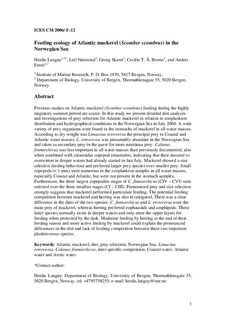Feeding ecology of Atlantic mackerel (Scomber scombrus) in the Norwegian Sea
Working paper

Åpne
Permanent lenke
http://hdl.handle.net/11250/100863Utgivelsesdato
2006Metadata
Vis full innførselSamlinger
Sammendrag
Previous studies on Atlantic mackerel (Scomber scombrus) feeding during the highly migratory summer period are scarce. In this study we present detailed diet analyses and investigations of prey selection for Atlantic mackerel in relation to zooplankton distribution and hydrographical conditions in the Norwegian Sea in July 2004. A wide variety of prey organisms were found in the stomachs of mackerel in all water masses. According to dry weight was Limacina retroversa the principal prey in Coastal and Atlantic water masses. L. retroversa was presumably abundant in the Norwegian Sea and taken as secondary prey in the quest for more nutritious prey. Calanus finmarchicus was less important in all water masses than previously documented, also when combined with calanoidae copepod remainders, indicating that their descend to overwinter in deeper waters had already started in late July. Mackerel showed a size selective feeding behaviour and preferred larger prey species over smaller prey. Small copepods (< 1 mm) were numerous in the zooplankton samples in all water masses, especially Coastal and Atlantic, but were not present in the stomach samples. Furthermore, the three largest copepodite stages of C. finmarchicus (CIV – CVI) were selected over the three smallest stages (CI – CIII). Pronounced prey and size selection strongly suggests that mackerel performed particulate feeding. The potential feeding competition between mackerel and herring was also investigated. There was a clear difference in the diets of the two species. C. finmarchicus and L. retroversa were the main prey of mackerel, whereas herring preferred euphausiids and amphipods. These latter species normally swim in deeper waters and only enter the upper layers for feeding when protected by the dark. Moderate feeding by herring at the end of their feeding season and more active feeding by mackerel could explain the pronounced differences in the diet and lack of feeding competition between these two important planktivorous species.
Utgiver
ICESSerie
ICES CM documents2006/ F:12